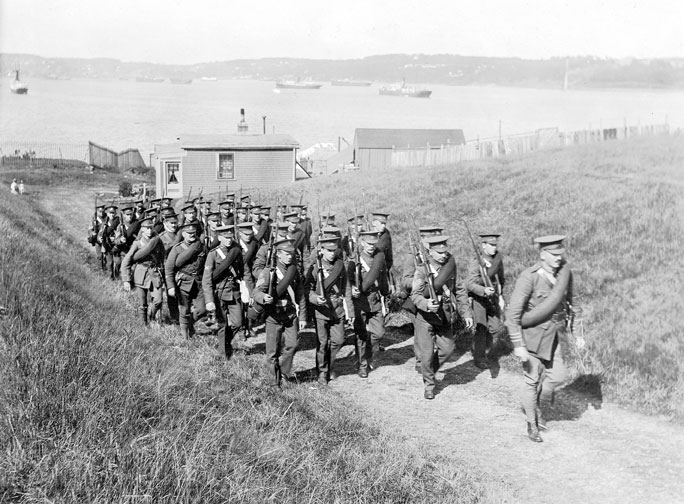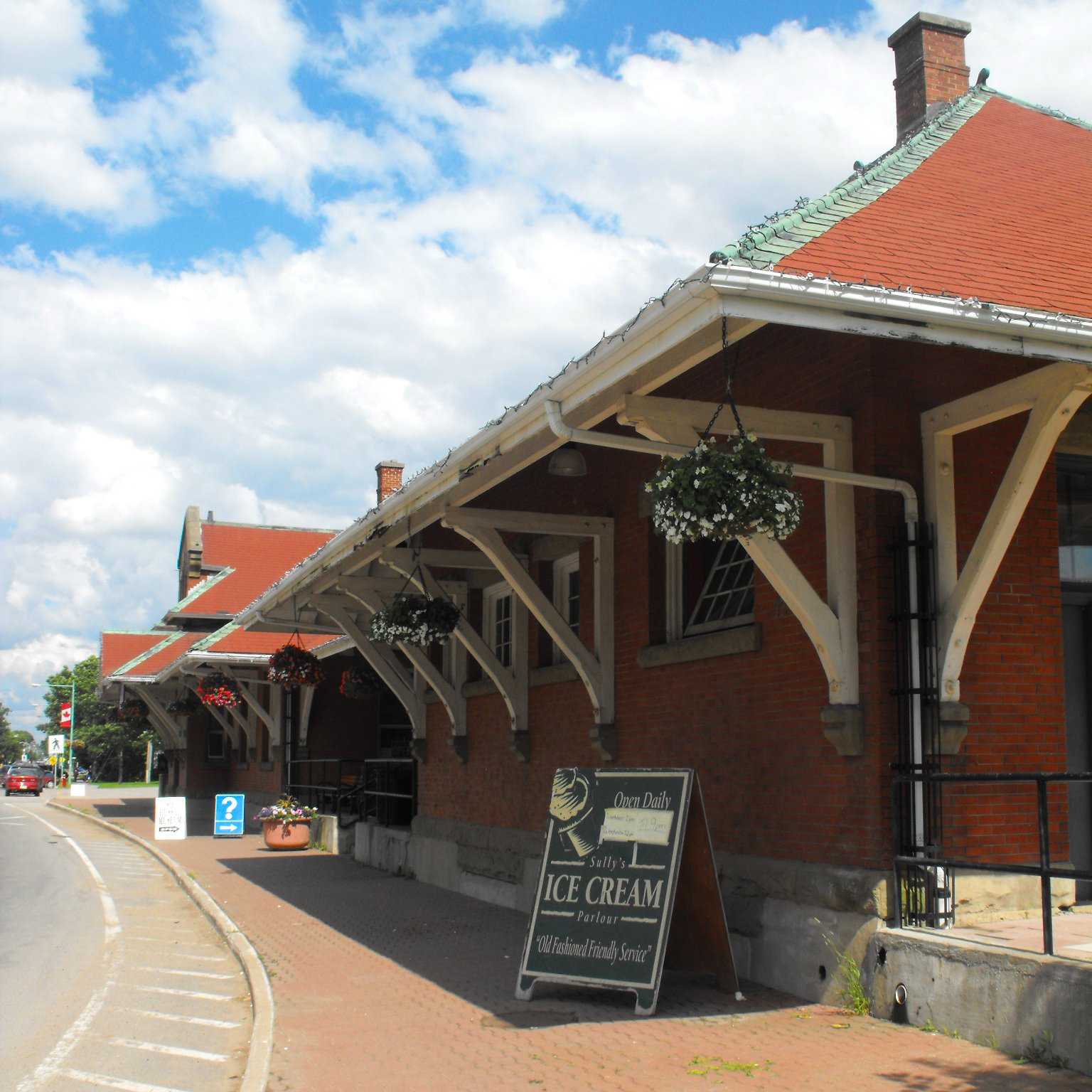|
North Shore Regiment
The North Shore (New Brunswick) Regiment is a Primary Reserve infantry regiment of the Canadian Army, and is part of the 5th Canadian Division's 37 Canadian Brigade Group. The regiment is headquartered in Bathurst, New Brunswick, with sub-units located in Newcastle (present day Miramichi), Campbellton and Moncton. Lineage The North Shore (New Brunswick) Regiment *Originated 25 February 1870 in Chatham, New Brunswick, as "The 73rd Northumberland New Brunswick" Battalion of Infantry *Re-designated 8 May 1900 as the 73rd Northumberland Regiment *Re-designated 15 March 1920 as The Northumberland (New Brunswick) Regiment *Re-designated 1 April 1922 as The North Shore (New Brunswick) Regiment *Re-designated 7 November 1940 as the 2nd (Reserve) Battalion, The North Shore (New Brunswick) Regiment *Re-designated 13 April 1946 as The North Shore (New Brunswick) Regiment *Amalgamated 30 September 1954 with the 28th Field Battery, RCA and re-designated as the 2nd Battalion, The New Brunswic ... [...More Info...] [...Related Items...] OR: [Wikipedia] [Google] [Baidu] |
37 Canadian Brigade Group
37 Canadian Brigade Group (french: 37e Groupe-brigade du Canada) is a reserve component brigade of the Canadian Army The Canadian Army (french: Armée canadienne) is the command responsible for the operational readiness of the conventional ground forces of the Canadian Armed Forces. It maintains regular forces units at bases across Canada, and is also respo ..., which supervises Militia units in 5th Canadian Division for New Brunswick and Newfoundland and Labrador. It was created in 1992 by merging the New Brunswick Militia District and the Newfoundland and Labrador Militia District. Brigade units References Brigades of the Canadian Army Military units and formations established in 1992 Organizations based in Moncton {{Canada-mil-stub ... [...More Info...] [...Related Items...] OR: [Wikipedia] [Google] [Baidu] |
Canadian Field Artillery
, colors = The guns of the RCA themselves , colors_label = Colours , march = * Slow march: "Royal Artillery Slow March" * Quick march (dismounted parades): "British Grenadiers/ The Voice of the Guns" * Trot past: "Keel Row" * Gallop past (horse artillery only): "Bonnie Dundee" , mascot = , anniversaries = * 1855: Militia Act of 1855 passed by the Parliament of the Province of Canada and creation the first truly Canadian army units * 27 November 1856: first Canadian Artillery unit formed (''Battalion of Montreal Artillery'') * 10 August 1883: ''Regiment of Canadian Artillery'' of the Permanent Active Militia authorized to be formed , equipment = * 105 mm Howitzer, C3 * 105 mm Howitzer, LG1 Mk II * 155 mm Howitzer M777C1 , equipment_label = Current weapon systems , battle_honours = The word la, Ubique, lit=Everywhere, take ... [...More Info...] [...Related Items...] OR: [Wikipedia] [Google] [Baidu] |
Caen
Caen (, ; nrf, Kaem) is a commune in northwestern France. It is the prefecture of the department of Calvados. The city proper has 105,512 inhabitants (), while its functional urban area has 470,000,Comparateur de territoire INSEE, retrieved 20 June 2022. making Caen the second largest urban area in and the 19th largest in France. It is also the third largest commune in all of Normandy after and Rouen. It is located inland ... [...More Info...] [...Related Items...] OR: [Wikipedia] [Google] [Baidu] |
Operation Windsor
Operation Windsor was a Canadian attack, which was part of the Battle of Normandy during the Second World War. The attack was undertaken by the 3rd Canadian Infantry Division to take Carpiquet and the adjacent airfield, from troops of the of . The attack was originally intended to take place during the later stages of Operation Epsom, to protect the eastern flank of the main assault but was postponed for a week. On 4 July, the 8th Canadian Infantry Brigade and an attached battalion of the 3rd Canadian Infantry Division attacked Carpiquet, supported on the flanks by the 2nd Canadian Armoured Brigade. The village was captured by mid-afternoon but German resistance in the south defeated two attacks on the airfield, despite significant Allied tank and air support. Next day the Canadians repulsed German counter-attacks and held the village, which served as a base for Operation Charnwood, a Second Army attack on Caen, involving the rest of the 3rd Canadian Infantry Division on 8 July ... [...More Info...] [...Related Items...] OR: [Wikipedia] [Google] [Baidu] |
D-Day
The Normandy landings were the landing operations and associated airborne operations on Tuesday, 6 June 1944 of the Allied invasion of Normandy in Operation Overlord during World War II. Codenamed Operation Neptune and often referred to as D-Day, it was the largest seaborne invasion in history. The operation began the liberation of France (and later western Europe) and laid the foundations of the Allied victory on the Western Front. Planning for the operation began in 1943. In the months leading up to the invasion, the Allies conducted a substantial military deception, codenamed Operation Bodyguard, to mislead the Germans as to the date and location of the main Allied landings. The weather on D-Day was far from ideal, and the operation had to be delayed 24 hours; a further postponement would have meant a delay of at least two weeks, as the invasion planners had requirements for the phase of the moon, the tides, and the time of day that meant only a few days each month were d ... [...More Info...] [...Related Items...] OR: [Wikipedia] [Google] [Baidu] |
Canadian Army Film And Photo Unit
The Canadian Army Film and Photo Unit (CFPU) was a Canadian Army unit founded in 1941 in order to document military operations during World War II. It was the last unit of its kind to be founded by the Allied armies. Among the campaigns which it recorded were the invasion of Sicily, the D-Day Landings, the liberation of Paris and the Elbe River link-up of the Allied armies, known as 'Elbe Day'. History The first official Canadian army photographer was Lieutenant Laurie Audrain of Winnipeg; he was appointed on June 25, 1940. However, it was soon recognized that a dedicated photographic unit was necessary. The CFPU was formed on June 19, 1941 under the command of Captain William Abell of Winnipeg. By the end of World War II, fifty nine Canadian photographers and cameramen had been involved in combat operations in Europe. Of these, six were killed and eighteen were wounded. The CFPU was staffed by enlisted men and women. Its objectives were to film Canadian troops in action and s ... [...More Info...] [...Related Items...] OR: [Wikipedia] [Google] [Baidu] |
Saint-Aubin-sur-Mer, Calvados
Saint Aubin-sur-Mer (, literally ''Saint Aubin on Sea'') is a commune in the Calvados department, in northwestern France. Administratively, it is part of the arrondissement of Caen and the canton of Courseulles-sur-Mer. It is 2.1 km east of Bernières-sur-Mer, 4 km north of Douvres-la-Délivrande and 16 km north of Caen. History Origins Up until July 1851, Saint-Aubin-sur-Mer was part of the commune of Langrune-sur-Mer. Upon its creation in 1851, by the will of Napoleon III , Saint-Aubin had a population of and Langrune . Nicknamed "Queen of Iodine", at low tide its banks of seaside rocks expose, an air of iodine saturates the beaches, thanks to the bladder-fucus and kelp deposited there. During the second half of the 19th century, the population of Saint-Aubin declined to the point that in 1901, there were only inhabitants. In July 1876, a train station was opened in Saint-Aubin along the Caen à la mer line, permitting the development of a sea resort. ... [...More Info...] [...Related Items...] OR: [Wikipedia] [Google] [Baidu] |
Juno Beach
Juno or Juno Beach was one of five beaches of the Allied invasion of German-occupied France in the Normandy landings on 6 June 1944 during the Second World War. The beach spanned from Courseulles, a village just east of the British beach Gold, to Saint-Aubin-sur-Mer, and just west of the British beach Sword. Taking Juno was the responsibility of the Canadian Army, with sea transport, mine sweeping, and a naval bombardment force provided by the Royal Canadian Navy and the British Royal Navy as well as elements from the Free French, Norwegian, and other Allied navies. The objectives of the 3rd Canadian Infantry Division on D-Day were to cut the Caen-Bayeux road, seize the Carpiquet airport west of Caen, and form a link between the two British beaches on either flank. The beach was defended by two battalions of the German 716th Infantry Division, with elements of the 21st Panzer Division held in reserve near Caen. The invasion plan called for two brigades of the 3rd Canadi ... [...More Info...] [...Related Items...] OR: [Wikipedia] [Google] [Baidu] |
Sussex, New Brunswick
Sussex is a town in Kings County, New Brunswick, Kings County, New Brunswick, Canada. Sussex is located in south central New Brunswick, between the province's three largest cities, Saint John, Moncton, and Fredericton. Sussex straddles the Kennebecasis River, northeast of Saint John, New Brunswick, Saint John, and is a major dairy product producer in the province. It is home to Atlantic Canada's largest hot air balloon festival. History In 1857 the European and North American Railway was opened, connecting the farming communities of the Kennebecasis River valley with Saint John and Moncton. Sussex was incorporated in accordance with Chapter 44 of the Town Incorporation Act of 1896 and was officially established as a Town on June 2, 1904. The settlers were for the most part United Kingdom, British Loyalist (American Revolution), Loyalists who had fled the American Revolution in 1776, with many Ireland, Irish refugees of the Great Famine (Ireland), Great Famine from the m ... [...More Info...] [...Related Items...] OR: [Wikipedia] [Google] [Baidu] |
Woodstock, New Brunswick
Woodstock is a town in Carleton County, New Brunswick, Canada on the Saint John River, 103 km upriver from Fredericton at the mouth of the Meduxnekeag River. It is near the Canada–United States border and Houlton, Maine and the intersection of Interstate 95 and the Trans-Canada Highway making it a transportation hub. It is also a service centre for the potato industry and for more than 26,000 people in the nearby communities of Hartland, Florenceville-Bristol, Centreville, Bath, Meductic, and Canterbury for shopping, employment and entertainment. Woodstock was possibly named after Woodstock, Oxfordshire. The name is Old English in origin, meaning a "clearing in the woods". New Brunswick historian William Francis Ganong believed the parish (and later town) was named in honour of Viscount Woodstock, a junior title of the Duke of Portland, Prime Minister of Great Britain when the Loyalists arrived in New Brunswick. History Little is known of the area before ... [...More Info...] [...Related Items...] OR: [Wikipedia] [Google] [Baidu] |
3rd Canadian Infantry Division
The 3rd Canadian Division is a formation of the Canadian Army responsible for the command and mobilization of all army units in the provinces of Manitoba, Saskatchewan, Alberta and British Columbia, as well as all units extending westwards from the city of Thunder Bay. It was first created as a formation of the Canadian Corps during the First World War. It was stood down following the war and was later reactivated as the 3rd Canadian Infantry Division during the Second World War. The second iteration served with distinction from 1941 to 1945, taking part in the D-Day landings of 6 June 1944. A duplicate of the 3rd Canadian Division was formed in 1945 to serve on occupation duty in Germany and was disbanded the following year. History First World War The 3rd Canadian Division was formed in France in December 1915 under the command of Major-General Malcolm Mercer. Its members served in France and Flanders until Armistice Day. While with the 3rd Division at Ypres, Mercer became t ... [...More Info...] [...Related Items...] OR: [Wikipedia] [Google] [Baidu] |
165th Battalion (Acadiens), CEF
The 165th (French Acadian) Battalion, CEF was a unit in the Canadian Expeditionary Force during the First World War. Based in Moncton, New Brunswick, the unit began recruiting in late 1915 throughout the Maritime provinces. After sailing to England in March 1917, the battalion was absorbed into the 13th Reserve Battalion on April 7, 1917. The 165th (French Acadian) Battalion, CEF had one Officer Commanding: LCol L. C. D'Aigle. The 165th Battalion is perpetuated by The North Shore (New Brunswick) Regiment. See also *Military history of the Acadians The military history of the Acadians consisted primarily of militias made up of Acadian settlers who participated in wars against the English (the British after 1707) in coordination with the Wabanaki Confederacy (particularly the Mi'kmaw mili ... References Sources * Meek, John F. ''Over the Top! The Canadian Infantry in the First World War.'' Orangeville, Ont.: The Author, 1971. Military units and formations of Ne ... [...More Info...] [...Related Items...] OR: [Wikipedia] [Google] [Baidu] |







